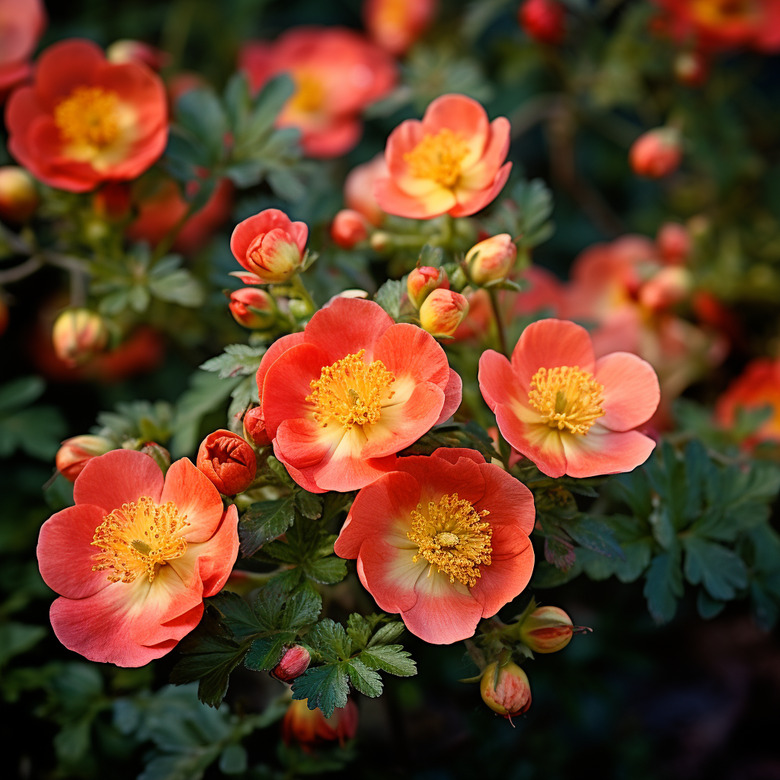How To Grow Potentilla Shrubs
If you're looking for an attractive shrub of a manageable size that has an extra-long blooming season, the potentilla shrub (_Potentilla spp.) could be a perfect choice for you. Also called cinquefoil, a French word referring to its five-petaled flowers, this group of plants includes herbaceous perennials that die to the ground during winter, along with shrubby cinquefoil (Potentilla fruticosa_), a woody, semi-evergreen plant that's 1 to 3 feet tall, depending on the cultivar. It grows in U.S. Department of Agriculture plant hardiness zones 3 through 7 and needs only basic care to thrive.
Choosing a Site
Shrubby cinquefoil is adaptable to different light conditions, growing best in full sun but also tolerating partial shade. If summer sun is hot where you live, choose a spot where the plant gets some light shade during summer afternoons.
Cinquefoil also isn't fussy about soil provided it's well-drained; the plant can grow in sandy, rocky soil but also does well in loamy soil. If your soil is high in clay and tends to drain slowly, add about 2 inches of coarse sand to your planting area, mixing it into the top 6 to 8 inches of soil. Boosting your soil's fertility with compost can also help get the plant off to a good start; mix about 2 inches into the area with a spade or fork before planting a new cinquefoil.
- If you're looking for an attractive shrub of a manageable size that has an extra-long blooming season, the potentilla shrub (Potentilla spp.)
- could be a perfect choice for you.
- Cinquefoil also isn't fussy about soil provided it's well-drained; the plant can grow in sandy, rocky soil but also does well in loamy soil.
Tip
Cinquefoil attracts honeybees and caterpillars of butterflies and moths, but isn't eaten by deer.
Providing Adequate Space
When planting a young cinquefoil, it's important to keep the shrub's mature size in mind so that you give it enough room to spread fully. The shrub comes in several different varieties, so check with your nursery or read your plant tag to determine how large it becomes, and plan accordingly. For example, **'Coronation Triumph'** (Potentilla fruticosa 'Coronation Triumph') can be 4 feet tall and wide; if you plant several of these, space them at least 4 feet apart, and allow 2 feet of free space in all directions around a single shrub. Another type called **'Hallman Dwarf'** (Potentilla fruticosa 'Hallman Dwarf') is only about 18 inches tall and wide, so space these plants 18 inches apart. Both varieties grow in USDA zones 3 through 7.
Watering, Fertilizing and Other Care
Cinquefoil shrubs are quite tolerant of dry conditions once established, but a newly planted shrub benefits from even moisture for its first growing season. Provide extra water whenever the top inch of soil feels dry to your fingertip, but water with a soaker hose or drip irrigation to keep foliage dry; this helps prevent growth of fungal organisms. It's also helpful to water early in the day so water dries quickly.
- When planting a young cinquefoil, it's important to keep the shrub's mature size in mind so that you give it enough room to spread fully.
- The shrub comes in several different varieties, so check with your nursery or read your plant tag to determine how large it becomes, and plan accordingly.
This shrub doesn't require fertilization, but you can give it a boost by feeding it in late winter or very early spring, just before it puts out new growth; wait until the second year after planting, to avoid burning new roots. Use a granular formula designed for roses, such an organic 4-3-2 product, mixing about 1 1/4 cup into the top inch of soil around each plant, but check your product label for further directions. Water fertilizer in well.
Cinquefoil doesn't need regular pruning, but you should remove any crossing branches that rub on each other or any that become damaged, doing this in late winter or early spring, before new growth starts. You can also prune in fall after the plant becomes dormant, but avoid pruning in summer while the shrub's growing actively. If flowering slows on older branches, stimulate new growth by removing some older branches at their origins from larger branches or at ground level.
Avoiding Problems
A cinquefoil shrub is usually free of any serious pest or disease problems. It might attract spider mites, microscopic pests that make web-like coverings on leaves and stems. Control these by spraying with **insecticidal soap,** diluted at a rate of 5 tablespoons per gallon of water; repeat the treatment every two weeks as needed. The plant might develop some fungal problems — dark spots on leaves or fluffy white mildew — if grown in overly damp conditions. To prevent these problems, remove any plant debris regularly and only water at the plant's base.
- This shrub doesn't require fertilization, but you can give it a boost by feeding it in late winter or very early spring, just before it puts out new growth; wait until the second year after planting, to avoid burning new roots.
- Cinquefoil doesn't need regular pruning, but you should remove any crossing branches that rub on each other or any that become damaged, doing this in late winter or early spring, before new growth starts.
